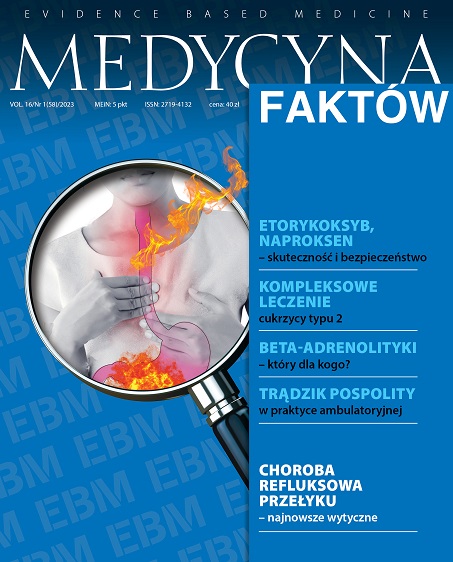Bezpieczeństwo kardiologiczne stosowania etorykoksybu Opis przypadku
##plugins.themes.bootstrap3.article.main##
Abstrakt
Etorykoksyb jest wysoce selektywnym inhibitorem cyklooksygenazy 2 wskazanym w łagodzeniu objawów zapalenia stawów i kości, reumatoidalnego zapalenia stawów oraz bólu i oznak zapalenia związanego z ostrym zapaleniem stawów dnawym. Selektywne niesteroidowe leki przeciwzapalne, takie jak etorykoksyb, powstały w wyniku wysiłków zaprojektowania niesteroidowych leków przeciwzapalnych, które poprzez mechanizm oszczędzający aktywność cyklooksygenazy 1 zmniejszałyby ryzyko działań niepożądanych w postaci toksyczności żołądkowo- jelitowej. W niniejszej pracy przedstawiono dwa przypadki kliniczne ilustrujące miejsce etorykoksybu w terapii choroby zwyrodnieniowej stawów i reumatoidalnego zapalenia stawów ze szczególnym uwzględnieniem bezpieczeństwa kardiologicznego.
##plugins.themes.bootstrap3.article.details##
Copyright © by Medical Education. All rights reserved.
Bibliografia
2. Mallen SR, Essex MN, Zhang R. Gastrointestinal tolerability of NSAIDs in elderly patients: A pooled analysis of 21 randomized clinical trials with celecoxib and nonselective NSAIDs. Curr Med Res Opin. 2011; 27: 1359-66.
3. Kocot-Kępska M. Etorykoksyb – nowe możliwości leczenia bólu. Skuteczność i bezpieczeństwo terapii (access: 24.01.2023).
4. Pawliczak R. Celekoksyb – nowe spojrzenie, nowe korzyści. Terapia. 2014; 12: 70-7.
5. Laine L, Curtis SP, Cryer B et al; MEDAL Steering Committee. Assessment of upper gastrointestinal safety of etoricoxib and diclofenac in patients with osteoarthritis and rheumatoid arthritis in the Multinational Etoricoxib and Diclofenac Arthritis Long-term (MEDAL) programme: a randomised comparison. Lancet. 2007; 369: 465-73.
6. van Walsem A, Pandhi S, Nixon RM et al. Relative benefit-risk comparing diclofenac to other traditional non-steroidal anti-inflammatory drugs and cyclooxygenase-2 inhibitors in patients with osteoarthritis or rheumatoid arthritis: a network meta-analysis. Arthritis Res Ther. 2015; 17: 66.
7. Combe B, Swergold G, McLay J et al. Cardiovascular safety and gastrointestinal tolerability of etoricoxib vs diclofenac in a randomized controlled clinical trial (The MEDAL study). Rheumatology (Oxford). 2009; 48: 425-32.
8. Cannon CP, Curtis SP, FitzGerald GA et al; MEDAL Steering Committee. Cardiovascular outcomes with etoricoxib and diclofenac in patients with osteoarthritis and rheumatoid arthritis in the Multinational Etoricoxib and Diclofenac Arthritis Long-term (MEDAL) programme: a randomised comparison. Lancet. 2006; 368: 1771-81.
9. Song GG, Seo YH, Kim JH et al. Relative efficacy and tolerability of etoricoxib, celecoxib, and naproxen in the treatment of osteoarthritis: A Bayesian network meta-analysis of randomized controlled trials based on patient withdrawal. Z Rheumatol. 2016; 75: 508-16.
10. Moore RA, Moore OA, Derry S et al. Responder analysis for pain relief and numbers needed to treat in a meta-analysis of etoricoxib osteoarthritis trials: bridging a gap between clinical trials and clinical practice. Ann Rheum Dis. 2010; 69: 374-9.
11. European Medicines Agency. Question and answers on the review of etoricoxib – containing medicines. Doc. Ref. EMEA/329177/2008.
12. Zacher J, Feldman D, Gerli R et al; etoricoxib OA study group. A comparison of the therapeutic efficacy and tolerability of etoricoxib and diclofenac in patients with osteoarthritis. Curr Med Res Opin. 2003; 19: 725-36.
13. Kurbiel A, Kocot-Kępska M, Przeklasa-Muszyńska A. Niesteroidowe leki przeciwzapalne do stosowania powierzchniowego w leczeniu choroby zwyrodnieniowej stawów – skuteczność i bezpieczeństwo etofenamatu. Ortopedia i Traumatologia. 2019; 2.
14. Contreras AE, Cervantes VM, Collantes-Esteves E. Update on the clinical pharmacology of etoricoxib, a potent cyclooxygenase-2 inhibitor. Future Rheumatol. 2007; 2: 545-65.
15. Piirainen A, Kokki M, Hautajärvi H et al. The Cerebrospinal Fluid Distribution of Postoperatively Administred Dexketoprofen and Etoricoxib and Their Effect on Pain and Inflammatory Markers in Patients Undergoing Hip Arthroplasty. Clin Drug Investig. 2016; 36: 545-55.
16. Moss P, Benson HAE, Will R et al. Fourteen days of etoricoxib 60 mg improves pain, hyperalgesia and physical function in individuals with knee osteoarthritis: a randomized controlled trial. Osteoarthritis Cartilage. 2017; 25: 1781-91.
17. Nor Azlin MI, Maryasalwati I, Norzilawati MN et al. The efficacy of etoricoxib vs mefenamic acid in the treatment of primary dysmenorrhoea: a randomised comparative trial. J Obstet Gynaecol. 2008; 28: 424-6.
18. Daniels SE, Bandy DP, Christensen SE et al. Evaluation of the dose range of etoricoxib in an acute pain setting using the postoperative dental pain model. Clin J Pain. 2011; 27: 1-8.
19. Clarke R, Derry S, Moore RA. Single dose oral etoricoxib for acute postoperative pain in adults. Cochrane Database Syst Rev. 2012; CD004309.
20. Maquirriain J, Kokalj A. Acute Achilles tendinopathy: effect of pain control on leg stiffness. J Musculoskelet Neuronal Interact. 2014; 14: 131-6.
21. Zhang S, Zhang Y, Liu P et al. Efficacy and safety of etoricoxib compared with NSAIDs in acute gout: a systematic review and a meta-analysis. Clin Rheumatol. 2016; 35: 151-8.
22. Lin TM, Chi JE, Chang CC et al. Do etoricoxib and indometacin have similar effects and safety for gouty arthritis? A meta-analysis of randomized controlled trials. J Pain Res. 2018; 12: 83-91.
23. Brooks P, Kubler P. Etoricoxib for arthritis and pain management. Ther Clin Risk Manag. 2006; 2: 45-57.
24. opis odsyłacza (access: 24.01.2023).
25. Gottesdiener K, Schnitzer T, Fisher C et al; Protocol 007 Study Group. Results of a randomized, dose-ranging trial of etoricoxib in patients with osteoarthritis. Rheumatology (Oxford). 2002; 41: 1052-61.
26. Walker C, Biasucci LM. Cardiovascular safety of non-steroidal anti-inflammatory drugs revisited. Postgrad Med. 2018; 130: 55-71.
27. Sattar N, McCarey DW, Capell H et al. Explaining how “high-grade” systemic inflammation accelerates vascular risk in rheumatoid arthritis. Circulation. 2003; 108: 2957-63.
